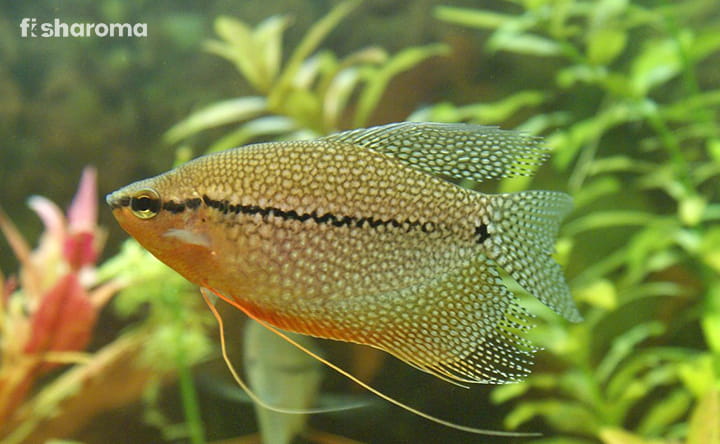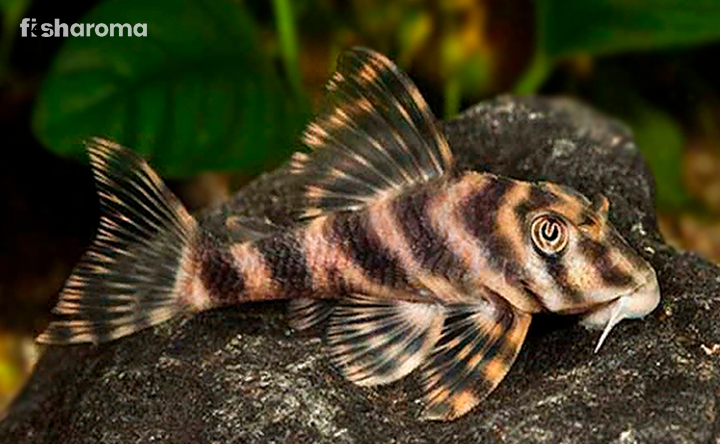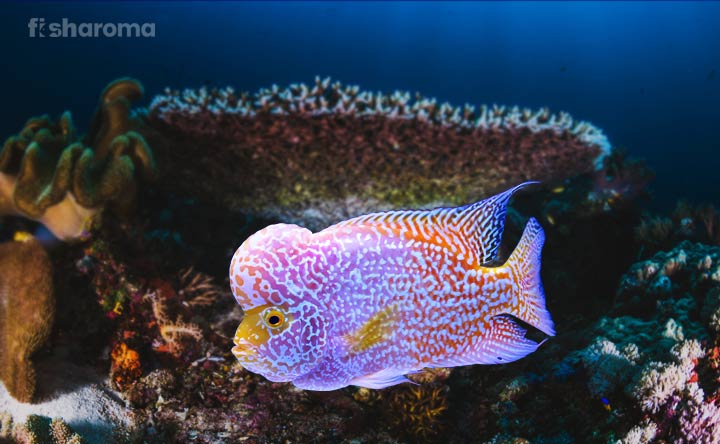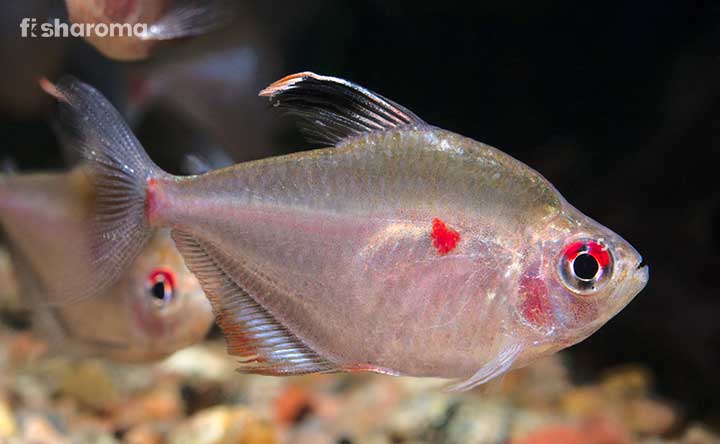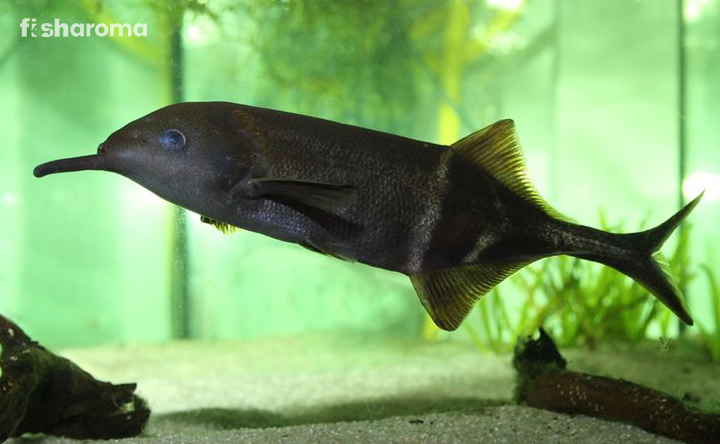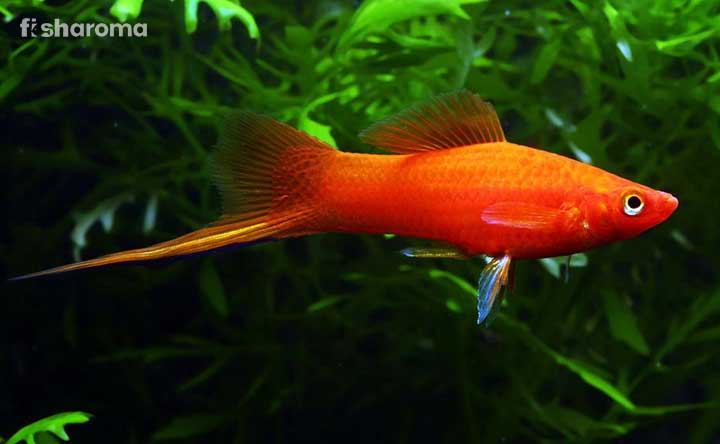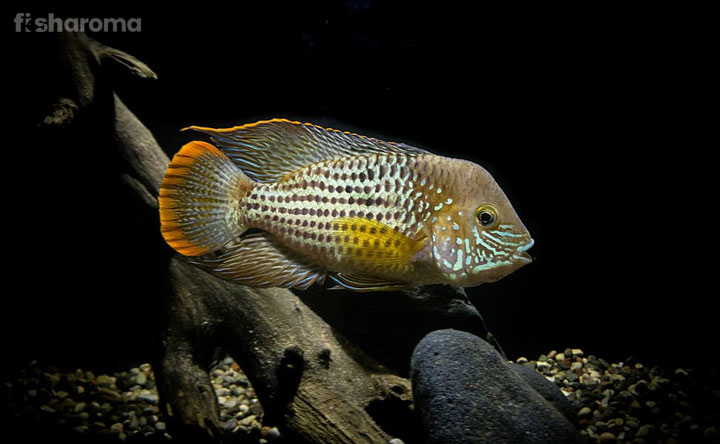Electric Blue Acara – The Compete Care Guide for This Mystical Fish

- Origin & Habitat of Electric Blue Acara
- Appearance of Electric Blue Acara
- Behaviour of Electric Blue Acara
- Lifespan of Electric Blue Acara
- Diet of Electric Blue Acara
- Tank Requirements for Electric Blue Acara
- Water Type for Electric Blue Acara
- Compatibility of Electric Blue Acara
- Breeding of Electric Blue Acara
- Electric Blue Acara Diseases
- Summary
Like a character straight out from a fairy tale, the Electric Blue Acara adds a majestic dimension to your aquarium. Not only are they easy on your eyes, but rearing them is extremely convenient due to their hardy nature. So, it makes absolute sense as to why their popularity is so high among aquarists. If you are planning on bringing them home, all you need to do beforehand is to go through our simple yet in-depth care guide wherein we are going to discuss everything from their behavior, diet, lifespan to their tank requirements, water type and much more.
Key Specifications of Electric Blue Acara
Before we breakdown each of the following categories in detail, take a quick look at their key specifications.
| Scientific Name | Andinoacara pulcher |
| Family | Cichlidae |
| Origin | Central & South America |
| Size | 7” (17 cm) |
| Color | Blue |
| Care Level | Easy |
| Lifespan | 10 Years |
| Temperament | Peaceful |
| Compatibility | Moderate |
| Tank Size | 30-Gallons |
| Diet | Omnivore |
Overview
Electric Blue Acaras are members of the Cichlidae family; however, they aren’t aggressive like the other members of their family. Scientifically, they were previously known as Aequidens pulcher but are now called Andinoacara pulcher.
Their strikingly regal appearance makes them an absolute favorite among fishkeepers. Add to that their peaceful demeanor, and you have got yourself a hassle-free aquatic pet. This is why they make for great tankmates in a community Cichlid aquarium.
Origin & Habitat of Electric Blue Acara
Electric Blue Acaras are native to Central and South America (Venezuela, Colombia, and Trinidad) with West Indies being its region of origin.
In the wild, they can be seen in both still and flowing waters of rivers. They thrive in warm freshwaters. Sands and thick vegetation are the primary attributes of their habitat.
Appearance of Electric Blue Acara
These freshwater beasts have an elongated, oval-shaped body that is compressed on the sides with beautiful, flowing, and pointed fins. They have one dorsal fin, which is circular in shape and is much larger than their pectoral, anal or pelvic fins. Males tend to have larger fins than their female counterparts and have a hump around their forehead.
Their eyes are a prominent feature of their body since they are pretty big and they protrude above their head. The thinnest part of the body of these species is where their abdomen merges into their caudal tail.
The densely-packed scales of their bodies help form their distinct cascades. Electric Blue Acaras’ heads are rounder than other members of Cichlids.
They have a set of pharyngeal teeth located in their throat, alongside their regular set of teeth. In addition, they also have spiny rays in the back of their dorsal, pectoral, anal, and pelvic fins to fight off predators.
Size of Electric Blue Acara
They are a mid-sized Cichlid that grows up to 7” (17 cm) in captivity and around 8” (20 cm) in the wild.
Color of Electric Blue Acara
Electric Blue Acaras drive their name from their electrifying appearance, and not because they emit electricity or something. Having a primarily light blue body that ranges from greyish-blue to dark blue, the scales on their bodies form a netted dark pattern across their skin. This blue gradually turns into dark grey or even black. There are around 5-8 black vertical stripes on their bodies that are pretty vague. Their face features few green horizontal lines.
They also have yellow, black or white spots on the sides. Their fins are also colored in blue although they have an edge of orange to them. In some variants, the fins also have a red rim on top. There is a clear black line present from their eye down to their cheek. Orange is also the color of their iris which encloses the dark pupil of their eyes.
The colors of a male Electric Blue Acara is more prominent than that of a female.
Behavior of Electric Blue Acara
Electric Blue Acaras don’t take have the aggression of the other members of their Cichlidae family. They are pretty peaceful, and the only aggression that they will showcase is when they are about to breed. They become slightly territorial during spawning.
They are easy-going and quite tolerant and accommodating of others. One of the most intriguing aspects of their behavior is their curious nature. You will often find them digging into the substrate and uprooting lightly-rooted plants. They are mostly seen swimming, although when threatened or stressed, they retreat and hide themselves.
Lifespan of Electric Blue Acara
One of the longest-living aquarium species, Electric Blue Acaras can live up to 10 years. In the wild, this number increases to even 20 years.
Diet of Electric Blue Acara
Debate of this species being omnivorous or carnivorous is still high among aquarists, but the fact that they are heavily dependent on a more carnivorous diet is for sure. In the wild, they are vicious predators. In captivity, they are open to both live and frozen foods alongside flakes and pellets.
An ideal diet of an Electric Blue Acara should consist of the following items:
- Cyclops
- Insect Larvae
- Earthworm
- Brine Shrimp
- Tubifex
- Blanched Cucumber
- Boiled Spinach
- Blanched Cabbage
- Boiled Peas
We recommend feeding them small quantities of food (2-5 small pinches) in a day instead of one large quantity in a day. Make sure their diet is enriched with vitamins. You can also feed them flakes and pellets.
Try to feed Red Earthworms to your Electric Blue Acara from time to time to give them the best coloration.
Tank Requirements for Electric Blue Acara
While setting the tank for your Electric Blue Acara, keep in mind the following aspects:
Tank Size
For a single Electric Blue Acara, you would require a 30-gallon tank. With each additional Acara you introduce to the tank, make sure you add 15 gallons of water space in their tank.
Substrate
As we have stated above, Electric Blue Acaras love to dig in the substrate. For them, the shape of their substrate matter much more than the type of the substrate. We recommend you use large even grain of sand or round gravel in your tank.
Filter
Coming to the choice of filtration, go for a regular filter on a medium-high setting that ensures proper aeration and low currents in the water. A powerhead or a canister filter seems suitable for their tank. However, use an air-powered filter in their breeding tank since a powerhead filter may suck up the fries.
Nature of Lighting
Electric Blue Acaras don’t have a fancy requirement of light. A simple aquarium lamp will suffice for them. However, the choice of lighting setup will be dictated by the type and number of aquatic plants you keep in your tank. If possible, expose them to sunlight for a very brief amount of time every day. Keeping the tank under sunlight for a long duration will however make the water too hot for them to survive.
Presence of Flora
In order to replicate the natural habitat of Electric Blue Acara, you need to make sure that the tank is densely planted. These plants provide hiding spots as well as shaded areas to these fish. Vallisneria and Sagittaria are good options for them.
Since they are known for uprooting plants, you can go for floating plants in their tank. For a breeding tank, large-leaved plants are a better option.
You may also keep dry Indian almond leaves since it would mimic the water conditions of the fish as well as be a food source for the juveniles.
Ornaments
Providing hiding to these fish is essential for lowering their stress levels. Therefore, include large non-sharp flat rocks, aquatic caves, castles, and driftwood in their tank.
Cleaning Method
Maintenance is a very big part of fishkeeping. One just can’t laze around and expect your fish to be healthy without you making any effort.
You need to practice regularity while cleaning your tank. We advise you to clean your tank once a month by transferring the water and fish to a bucket and putting the ornaments under running tap water. You can vacuum the substrate and scrap off algae off the walls. As for the plants, trim them so that they don’t go rogue. Dip a soft cloth in lukewarm water and wipe off the interior wall of your tank.
We strongly recommend not using any soap or chemical-based products since their leftover residue stays back even after washing them thoroughly, and they are extremely dangerous to your fish.
Water Type for Electric Blue Acara
Tap water is suitable for them as long as it doesn’t have a high level of chlorine or iron in it. In that case, you need to use filtered water.
Despite the fact that these fish don’t have any high-end demand regarding the water they need in the tank, you still need to be cautious about their health. Therefore, keep in mind the following instructions while providing the water for their tank.
Temperature
As they prefer slightly warm water, keep the temperature of the water between 72-86° F (22-30° C).
pH Level
The pH level of the water should be 6.5-8.0.
Hardness
Try and keep the general hardness of your tank at 3-20 dGH.
Replacement Procedure
Replacement of the tank water should be done at regular intervals so that your fish and aquatic plants get used to it. You can replace the tank water every seven days or every 15 days or every 30 days. If you want to replace it every seven days, then replace just 10% of the tank water; if you want to do it every 15 days, then replace 20% of the water; else replace 40% of the water if you are going for the 30-day plan.
The new batch of water that you add to the tank should have the same temperature, pH level, and hardness as that of the existing batch of water.
As you have noticed, we have never mentioned replacing the entire tank water altogether. This is because your tank water hosts beneficial bacteria in it that is responsible for maintaining the ecological balance of the tank.
Compatibility of Electric Blue Acara
Electric Blue Acaras have an amiable nature. Thus, they are compatible with a bunch of other species. You can also keep more than one Acara together. Keeping them in pairs or groups of at least six is recommended.
Suitable Tankmates for Electric Blue Acara
They are highly compatible with most other members of their Cichlid family. In addition, they can also be kept with species that are peaceful and are of similar size as of them. The ideal tankmates of an Electric Blue Acara are as follows:
- Zebra Cichlid
- Pearl Cichlid
- Velvet Cichlid
- Moga Cichlid
- Rainbowfish
- Corydoras
- Bristlenose Pleco
- Pictus Catfish
- Discus
Unsuitable Tankmates for Electric Blue Acara
Large, aggressive species such as Dwarf Cichlid and Green Terror Cichlid should not be kept with an Electric Blue Acara in the same tank, so are the small invertebrates because Acaras might harass or even consume them.
Breeding of Electric Blue Acara
They are one of the easiest Cichlids to breed. To facilitate their spawning, you need to provide a separate breeding tank to them. It should be a 20-gallon tank and must have fewer plants than the main tank.
Use large grains of sand as the substrate and cover it with large, flat rocks with non-sharp edges. The temperature should be 77° F (25° C) and the pH level should be slightly acidic at 6.5-7. Use a proper aeration system with the help of an air-powered filter. You can keep increasing the temperature of the water every day by one degree, but don’t exceed the 82° F (28° C) mark.
Pairs are usually formed naturally among them, which is why it is necessary to have them in groups in your main tank. They reach maturity at the age of 8-10 months. Once you have identified the pair, transfer them to the breeding tank.
Feed them chopped Earthworms and other live food daily for 2-3 weeks to help prepare them for the breeding procedure. Every week, replace 30% of the tank water as well.
You will notice them spending the majority of their time at the bottom of the tank since the rocks will act as their breeding ground. They also dig up burrows in the sand for providing shelter to their newborns. As their color starts intensifying, you have to understand that they are ready to spawn.
If you don’t keep a separate breeding tank, then they will display aggressiveness when they see other fish trespassing their territory.
Females usually lay 150-200 eggs and guard them for protection. If they are breeding for the first time, they might even consume their own eggs, although it stops in their second to third go. The males start fertilizing them soon after. The eggs start hatching within 3-7 days depending on the temperature of the tank water.
After Care
Electric Blue Acaras are mouthbrooders and carry their fries to the burrows that they dug up earlier. The juveniles start swimming and eating on their own in 3-4 days. You can provide freshly hatched Brine Shrimp, Nematodes, and Rotifers to them as food. They stay close to their mother for the first couple of weeks to the point that they don’t even leave their side.
Electric Blue Acaras are monogamous by nature and stay faithful to their partners. After one breeding session, they get ready to breed once again in two weeks which is enough time for them to recover from their previous breeding session and taking care of their fries.
Having more females than males in your main tank increases the chances of forming pairs.
Electric Blue Acara Diseases
These freshwater species are quite hardy by nature; however poor diet, not quarantining aquarium products and unhealthy water conditions can leave them susceptible to the following diseases:
- Ich – Its symptoms include white spots on the bodies, fins, and gills of the fish. You will also notice your fish rubbing their bodies against the tank wall or substrate, losing appetite, and suffering respiratory issues which will force them to rise to the water surface to breathe.
- Skin Fluke – It is mostly spread if you haven’t quarantined your fish after purchase and before putting them into the tank. This disease will lead to skin damage and you will see your fish losing its color and becoming lethargic and depressed.
- Malawi Bloat – A common disease in Cichlids, it is a bacterial infection that leads to a swollen abdomen and a loss of appetite. Internal organs such as liver and kidneys are also affected because of this, and so does the respiratory organs. There will be ulcerative spots and lesions on the bodies of your fish and their feces will become stringy and discolored.
Getting the help of a veterinarian is of utmost importance in these cases. Although you may try home remedies to get rid of these infections, you may end up harming them instead of helping them. So, medical help is the way to go.
Interesting Facts about Electric Blue Acara
- Electric Blue Acaras were first identified by American ichthyologist, malacologist, mammalogist, and librarian Theodore Nicholas Gill in the year 1858 in his book Synopsis of the Fresh Water Fishes of the Western Portion of the Island of Trinidad, WI.
- The frontal portions of the fins of these species are soft, allowing for effortless movements and precise positions in the water instead of fast swimming.
- They have a funny way of “smelling” water, wherein they suck water in and expel it back after “sampling” it for a period of time.
Summary
Electric Blue Acaras are one of the most peaceful and magnificent Cichlids that you can bring home. Not only are they easy to feed and breed, the demands of their living conditions are also very minimal. In addition, they are compatible with a bunch of other species. Therefore, they are an ideal option for beginners. We hope our care guide has put you in a better position in caring for them healthily.
Care Guides for Similar Unconventional Freshwater Species
Take a look at the care guides of other Cichlids:
- Firemouth Cichlid – Known for their teardrop-shaped body and fiery-red color, Firemouth Cichlids will keep you enthralled with their curious behavior.
- African Cichlid – Famous for their intelligent behavior, African Cichlids represent a group of Cichlids native to Lake Malawi and Lake Victoria.
- Convict Cichlid – A highly popular freshwater species, the black and white stripes of a Convict Cichlid sets them apart from other members of their family.

